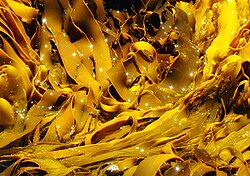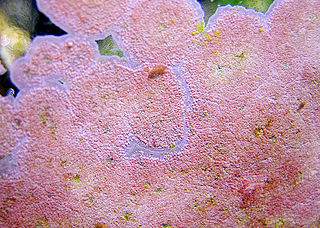
Coralline algae are red algae in the order Corallinales. They are characterized by a thallus that is hard because of calcareous deposits contained within the cell walls. The colors of these algae are most typically pink, or some other shade of red, but some species can be purple, yellow, blue, white, or gray-green. Coralline algae play an important role in the ecology of coral reefs. Sea urchins, parrot fish, and limpets and chitons feed on coralline algae. In the temperate Mediterranean Sea, coralline algae are the main builders of a typical algal reef, the Coralligène ("coralligenous"). Many are typically encrusting and rock-like, found in marine waters all over the world. Only one species lives in freshwater. Unattached specimens may form relatively smooth compact balls to warty or fruticose thalli.
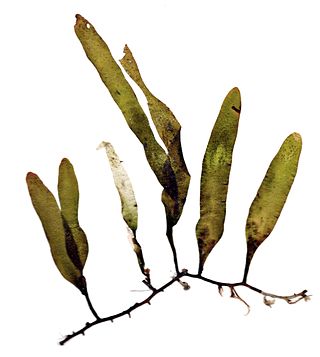
Caulerpa is a genus of seaweeds in the family Caulerpaceae. They are unusual because they consist of only one cell with many nuclei, making them among the biggest single cells in the world.

Porphyra is a genus of coldwater seaweeds that grow in cold, shallow seawater. More specifically, it belongs to red algae phylum of laver species, comprising approximately 70 species. It grows in the intertidal zone, typically between the upper intertidal zone and the splash zone in cold waters of temperate oceans. In East Asia, it is used to produce the sea vegetable products nori and gim. There are considered to be 60–70 species of Porphyra worldwide and seven around Britain and Ireland, where it has been traditionally used to produce edible sea vegetables on the Irish Sea coast. The species Porphyra purpurea has one of the largest plastid genomes known, with 251 genes.
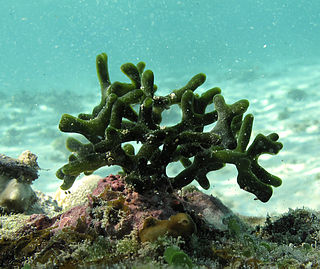
Codium is a genus of edible green macroalgae under the order Bryopsidales. The genus name is derived from a Greek word that pertains to the soft texture of its thallus. One of the foremost experts on Codium taxonomy was Paul Claude Silva at the University of California, Berkeley. Silva was able to describe 36 species for the genus, and in honor of his work on Codium, the species C. silvae was named after the late professor.
The history of phycology is the history of the scientific study of algae. Human interest in plants as food goes back into the origins of the species, and knowledge of algae can be traced back more than two thousand years. However, only in the last three hundred years has that knowledge evolved into a rapidly developing science.

Plocamium is a genus of red algae in the family Plocamiaceae. It contains around 40 species and has a cosmopolitan distribution in temperate seas, although it is most diverse in the southern hemisphere. It is widely distributed in tropical and also warm-temperate and cold-temperate seas, such as northern Europe, the northern Arabian Sea and western Australia. They are also found in the Antarctic regions of Admiralty Bay and Terra Nova Bay.

Laurencia is a genus of red algae that grow in temperate and tropical shore areas, in littoral to sublittoral habitats, at depths up to 65 m (213 ft).
Mary Winifred Parke, FRS, was a British marine botanist and Fellow of the Royal Society (1972) specialising in phycology, the study of algae.

Anna Antoinette Weber-van Bosse was a Dutch phycologist, specializing in marine algae.
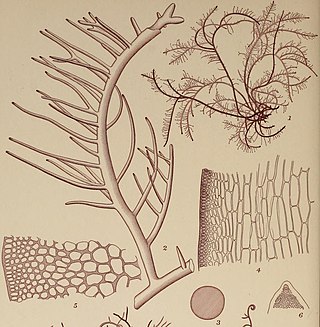
Hypnea is a genus of red algae, and a well known carrageenophyte.
Elsie Conway was a British phycologist. She served as president of the British Phycological Society from 1965 to 1967, and was one of the earliest women Fellows of the Royal Society of Edinburgh.
Madura S. Balakrishnan (1917–1990) was a mycologist and phycologist from Madras, India during the Madras Presidency. He served various government positions and worked for some time at the University of Pune. He was the student of Indian phycologist M.O.P. Iyengar.
Ethel Sarel Gepp, also publishing as Ethel Sarel Barton, was a phycologist who specialized in the study of marine algae and is noted for her work reordering the genus Halimeda.

Dictyota is a genus of brown seaweed in the family Dictyotaceae. Species are predominantly found in tropical and subtropical seas, and are known to contain numerous chemicals (diterpenes) which have potential medicinal value. As at the end of 2017, some 237 different diterpenes had been identified from across the genus.

Michael Dominic Richard Guiry, is an Irish botanist, who specialises in phycology (algae). See for example the articles. He is the founder and director of the algal database, AlgaeBase.
Valerie May was an Australian phycologist, a pioneer and noted expert on toxic algae and water quality, and an interdisciplinary scientist who undertook algal ecology studies in Australia.
The British Phycological Society, founded in 1952, is a learned society based in the United Kingdom promoting the study of algae. Members interests include all aspects of the study of algae, including both natural biodiversity and applied uses. It is the largest learned phycological society in Europe. Its membership is worldwide, although predominantly within the UK.
Margaret Constance Helen Blackler (1902–1981) was a British phycologist, botanical collector and museum curator.
Alan Bridson Cribb Jr. is an Australian botanist and mycologist and an expert in marine and freshwater algae and seaweeds. He has also written on native and wild foods of Australia.The standard author abbreviation Cribb is used to indicate this person as the author when citing a botanical name.
Joanna M. Jones was a phycologist, marine biologist and diver. She researched kelp forest ecology adding to the scientific knowledge on its population, reproduction, competition and growth as well as descriptions of subcanopy seaweeds found in kelp forests. She was president of the British Phycological Society from 1987 to 1988.
